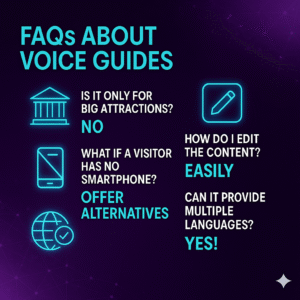“Create a personal and interactive visitor experience by building a custom Voice-Based Tour Guide that provides instant, conversational answers to visitor questions and offers self-guided exploration.”
Imagine this: your visitors are captivated and exploring your attraction. They’re not just looking; they’re engaging, asking questions, and receiving instant, insightful answers. This isn’t a futuristic dream. It’s the power of a voice-based tour guide, a tool that transforms the visitor experience from passive observation to active discovery.
For too long, museums, parks, and historical sites have relied on outdated methods. Think about it: static information boards, pre-recorded audio tours that offer a one-way conversation, and human guides, while invaluable, can only be in one place at a time. Today, there’s a better way.
This guide will walk you through creating your own interactive, voice-based tour guide. We’ll explore its immense benefits, detailing how it surpasses traditional methods. Then, we’ll break down the process, from crafting compelling content to designing a seamless conversational flow. Finally, we’ll introduce you to the ultimate tool for this endeavor: Scalewise.ai.
Why Ditch the Old for the New? The Benefits of a Voice-Based Tour Guide
Let’s be honest. Traditional tour methods have their limitations. They often feel rigid, failing to adapt to individual visitor interests. A voice-based tour guide, however, changes everything.
Enhanced Engagement: Making Every Visit Personal
Think about your last museum visit. Did you skip sections that didn’t immediately grab you? Most people do. A voice-based tour guide, a true AI tour guide, combats this. It doesn’t just present information; it responds.
Imagine a visitor pausing at a painting. Instead of reading a small plaque, they ask, “Tell me about the artist’s technique.” The guide instantly provides a detailed, relevant answer. This immediate feedback loop fosters deeper engagement. Visitors feel heard, and their curiosity is satisfied in real-time. This interactive visitor experience is far more memorable. They become active participants in their own learning journey, not just observers.
Easy Updates: Keeping Your Content Fresh and Accurate
Information changes, exhibits rotate, and new research emerges. With traditional audio guides, updating content is a chore. It often involves re-recording, re-uploading, and distributing new devices, which is a logistical nightmare.
A digital guide for landmarks or any attraction, powered by AI, makes updates incredibly simple. You edit the information in one central location. The changes are then immediately reflected in the voice-based guide. This means your visitors always receive the most current and accurate information. It’s a huge time-saver and ensures your content is always top-notch.
Accessibility for All: A More Inclusive Experience
Not everyone learns the same way. Some prefer to listen, and others might have visual impairments that make reading difficult. A voice-based tour guide, an essential part of smart tourism, addresses these needs directly.
It offers an auditory experience that is naturally more accessible. Visitors can listen at their own pace, pause, and replay sections as needed. This inclusivity broadens your audience and ensures a more enjoyable experience for everyone. It demonstrates a commitment to providing a welcoming environment.
Scalability: Handling Crowds with Ease
Peak seasons bring crowds, and human guides get stretched thin. Pre-recorded audio devices might run out or require constant sanitization. A voice-based guide, functioning as a self-guided tour app, eliminates these bottlenecks.
It can handle an unlimited number of simultaneous users. Visitors simply access the guide on their own smartphones. This means no more waiting for a tour group to form, no more device distribution headaches, and every visitor receives a consistent, high-quality experience, regardless of how busy your attraction is. It’s a truly efficient solution for managing visitor flow.
Multilingual Support: Welcoming the World
In today’s globalized world, visitors come from every corner. Offering information in multiple languages is crucial. Traditional methods often fall short, requiring separate recordings or limited language options.
An AI-powered voice guide can seamlessly integrate multiple languages. A visitor simply selects their preferred language, and the guide responds accordingly. This removes language barriers, making your attraction more inviting to international tourists. It significantly enhances their experience, allowing them to grasp the stories you’re telling fully. This is a key advantage for tourism AI.
Cost-Effectiveness: A Smart Investment
Initially, the idea of an AI tour guide might sound expensive. However, a voice-based solution is more cost-effective when considering the long-term costs of traditional methods – human guide salaries, audio device maintenance, and content updates.
Once set up, operational costs are minimal, updates are inexpensive, and you reduce reliance on large numbers of staff for guided tours. This makes it a wise, sustainable investment for any attraction looking to modernize its offerings.
The Journey to Your Voice-Based Tour Guide: Step-by-Step
Now that you understand the powerful advantages, let’s break down the creation process. This isn’t about complex coding but thoughtful planning and strategic implementation.
Step 1: Content is King – Scripting Your Story
The heart of any good tour is its story. For a voice-based guide, this means carefully crafting your content. Think beyond simple facts. What narratives do you want to tell? What emotions do you want to evoke?
Identify Key Points of Interest: Walk through your attraction. Pinpoint every exhibit, landmark, or historical site that warrants explanation. Don’t overlook the more minor, often-missed details that add depth.
Gather Information: Collect all relevant data, including historical facts, artistic details, scientific explanations, and anecdotes. The more information you have, the richer your guide will be.
Write Engaging Narratives: This is where the magic happens. Instead of dry descriptions, write captivating narratives. Use vivid language. Tell stories that draw visitors in. Consider different perspectives. For example, instead of just stating a date, describe the context and significance of that period.
Anticipate Questions: Put yourself in your visitors’ shoes. What questions would they naturally ask about each point of interest? List these questions. Then, draft clear, concise answers. This proactive approach is vital for an interactive experience. This is how you create an audio tour that truly responds.
Break Down Information into Bite-Sized Chunks: People have short attention spans. Avoid long, rambling explanations. Break your content into digestible segments. Each segment should focus on one key idea or answer one specific question.
Consider Different Visitor Levels: Your audience will have varying levels of prior knowledge. Some might be experts; others complete novices. Develop content that a broad audience can understand, but also allows for deeper dives for those who want them. For example, a basic explanation could be followed by an option to “tell me more about the scientific principles behind this.”
Step 2: Structuring the Conversation – Designing the Flow
This is where you move from static content to a dynamic, conversational experience. Think of it like designing a choose-your-own-adventure book, but with voice.
Define Start and End Points: How will visitors begin their tour? How will they know when they’ve completed it? Consider a clear welcome message and a summary or farewell at the end.
Map Out Paths and Branches: Most attractions have a logical flow. However, a voice-based guide offers flexibility. Allow visitors to explore non-linearly if they wish. Create branches in your conversational flow based on potential questions or areas of interest.
For example:
- “You are currently at the [Exhibit Name]. Would you like to hear about its history, the artist, or significance?”
- If they choose “history,” the guide provides the historical context.
- After that, it might ask, “Is there anything else you’d like to know about this exhibit?”
Implement Keywords and Triggers: How will the guide know what visitors ask about? This involves identifying keywords or phrases that will trigger specific responses. For example, if a visitor says, Who created this?” the guide should be able to locate “created” and “this” (referring to the current exhibit) to provide the artist’s name. This is crucial for a museum audio guide.
Design for Natural Language Understanding: The best voice-based guides don’t require specific commands. They understand natural language. While the underlying technology handles this, your content structure can aid it. Write questions and answers in a conversational tone.
Include Navigation Cues: How will visitors move between points of interest? The guide can offer suggestions, such as, “If you turn left, you’ll find the ancient pottery collection.” This helps with the self-guided tour app’s functionality.
Plan for “No Information” Scenarios: What if a visitor asks a question the guide doesn’t have an answer for? Instead of a dead end, plan a polite response. “That’s a great question! I don’t have that information right now, but I can tell you more about…”
Step 3: Choosing Your Tool – The Power of an AI Agent Builder
You’ve got your content. You’ve mapped your conversational flow. Now, how do you bring it to life? This is where an AI Agent Builder comes in. You no longer need to be a programmer to create an audio tour.
Building an AI tour guide traditionally involved complex coding, hiring specialists, and significant financial investment. Not anymore. Modern no-code platforms have democratized this technology.
Look for a platform that offers:
- No-Code Interface: This is paramount. You want a drag-and-drop or intuitive text-based interface, not lines of code.
- Natural Language Processing (NLP) Capabilities: The platform should be able to understand and interpret human language effectively.
- Text-to-Speech (TTS) Integration: It needs to convert your written content into natural-sounding speech.
- Easy Content Management: Updating your content should be straightforward.
- Scalability: It should be able to handle a large number of simultaneous users.
- Analytics: Understanding how visitors interact with your guide can provide valuable insights for improvement.
Introducing Scalewise.ai: Your Partner in Smart Tourism
Now, let’s talk about the tool that combines all this seamlessly and powerfully: Scalewise.ai.
Scalewise.ai isn’t just another platform. It’s a game-changer for any attraction looking to create a voice-based tour guide. It stands out as a free, no-code AI Agent Builder. As an owner or manager, you can build a custom AI tour guide without technical expertise or a hefty budget.
What Makes Scalewise.ai the Ultimate Tool?
Free and No-Code: This is a significant advantage. You get powerful AI capabilities without the typical cost or complexity. This lowers the barrier to entry for even smaller attractions. You don’t need to hire developers or invest in expensive software licenses. You simply sign up and start building.
Custom AI Agent Builder: Scalewise.ai empowers you to build an AI agent tailored to your attraction. It’s not a generic solution. You input your unique content, specific questions, and desired conversational flow. This results in a custom digital guide for landmarks, museums, or historical sites.
Shares Knowledge Effortlessly: The core function of your voice-based tour guide is to share information. Scalewise.ai excels at this. You feed it your meticulously crafted content, and it intelligently processes and delivers that knowledge to your visitors. It becomes an extension of your curatorial team, always available and knowledgeable.
Answers Visitor Questions in Real-Time: This is where the interactive visitor experience truly shines. Scalewise.ai’s AI agents are designed to instantly understand and respond to visitor questions. A visitor asks about an artifact’s origin, and the guide answers within seconds. This immediate gratification keeps visitors engaged and satisfied.
Creates a Modern, Memorable Experience: Visitors expect more than static displays in today’s digital age. They want interaction. They want personalization. Scalewise.ai helps you deliver exactly that. By offering a voice-based, AI-powered guide, you position your attraction at the forefront of smart tourism. You provide an experience that is not only informative but also exciting and memorable. Visitors will remember the attraction, where they can simply ask a question and get an intelligent response.
Easy to Use Interface: Scalewise.ai prides itself on an intuitive user interface. You don’t need to be an AI expert. The platform guides you through the process, making straightforward content input, flow design, and agent training. This means you can get your voice-based tour guide up and running quickly.
Scalable for Any Attraction: Whether you’re a small local museum or a sprawling national park, Scalewise.ai can handle your needs. The platform is built to scale, ensuring consistent performance regardless of your visitor numbers. This makes it a reliable solution for long-term growth.
Continuous Improvement: The nature of AI means your guide can get smarter over time. As more visitors interact with it, the platform can learn and refine its responses. This ongoing improvement ensures your voice-based tour guide consistently delivers a high-quality experience.
Implementing Your Voice-Based Tour Guide
Once you’ve built your AI agent with Scalewise.ai, implementing it for your visitors is the final step.
Platform Integration: Decide how visitors will access the guide.
- Web-based application: Visitors scan a QR code at the entrance or at specific exhibits. This opens a web page on their phone, allowing them to interact with the voice guide.
- Dedicated app: If you already have an attraction app, you might integrate the AI agent directly into it.
- On-site devices: While the beauty of this system is using personal devices, some attractions might still offer a limited number of dedicated tablets with the guide pre-installed.
Clear Signage: Ensure clear, easy-to-understand signage throughout your attraction. Tell visitors about the voice-based tour guide. Explain how to access it (e.g., “Scan here for your personal AI tour guide!”).
Promotion: Announce your new interactive visitor experience through your website, social media, and local tourism boards. Highlight the benefits: real-time answers, personalized tours, and engaging stories.
Staff Training: Inform your staff about the new guide. They should understand how it works and be able to assist visitors with accessing it. This ensures a smooth transition and positive visitor experience.
Gather Feedback: After launch, actively seek feedback from your visitors. What did they like? What could be improved? Use this feedback to refine your content and conversational flow in Scalewise.ai. This continuous improvement loop is vital for success.
Beyond the Basic Tour: Expanding Your Voice Guide’s Capabilities
Once you have a functional voice-based tour guide, the possibilities extend beyond basic information delivery.
Gamification: Turn the tour into a game! Create quizzes or scavenger hunts that the voice guide helps visitors complete. This adds another layer of fun and engagement.
Personalized Recommendations: Based on a visitor’s interactions, the guide could offer customized recommendations for other exhibits, nearby attractions, or even local dining options.
Visitor Services: The guide could answer common operational questions like, “Where are the restrooms?” “What are your opening hours?” “Is there a cafe nearby?” This would free up staff for more complex inquiries.
Collecting Insights: The data from visitor interactions can provide invaluable insights into popular exhibits, common questions, and areas of confusion. This information can help you improve your exhibits and overall visitor experience.
Interactive Storytelling: Create immersive stories where visitors make choices that influence the narrative. This is particularly powerful for historical sites or themed attractions.
Educational Tool for Schools: Offer a specialized version of the guide for school groups, tailored to specific curriculum requirements.
Conclusion: Embrace the Future of Visitor Engagement
The world of tourism is constantly evolving. Visitors expect more. They seek deeper connections, personalized experiences, and instant information. Traditional tour methods, while having their place, often fall short of these modern expectations.
Creating a voice-based tour guide for your attraction is about keeping up with trends and setting a new standard for visitor engagement. It’s about transforming passive viewing into active discovery and making every visit a memorable, insightful, and personal journey.
Scalewise.ai offers a revolutionary solution to achieve this. You can easily build a custom AI tour guide with its free, no-code AI Agent Builder. This powerful tool empowers your attraction to share knowledge, answer visitor questions in real-time, and provide a truly modern and unforgettable experience.
Don’t let your attraction be left behind. Embrace the future of visitor engagement. Start building your voice-based tour guide today with Scalewise.ai, and watch your visitor experience flourish.
FAQs: Your Questions Answered
Q: Is a voice-based tour guide only for large museums?
A: Absolutely not! Any attraction, regardless of size—a small historical society, a botanical garden, a local art gallery, or even a public park with points of interest—can benefit from tools like Scalewise.ai. The beauty of tools like Scalewise.ai is their accessibility for all.
Q: Do visitors need a special app to use it?
A: Not necessarily. While some attractions might integrate it into an existing app, many voice-based guides can be accessed directly through a web browser on a smartphone. Visitors simply scan a QR code, making it incredibly convenient.
Q: What about visitors who don’t have a smartphone?
A: It’s always a good idea to have alternative options. You can offer limited traditional audio devices for those without smartphones or provide printed guides. However, the vast majority of visitors today carry smartphones.
Q: How do I update the content if an exhibit changes?
A: This is one of the most significant advantages! With a platform like Scalewise.ai, you log into your account and edit the specific information, and the changes are almost live. There’s no need for re-recording or physical device updates.
Q: Can the voice guide really understand complex questions?
A: Modern AI has advanced significantly, primarily through platforms like Scalewise.ai. While it might not understand every nuance of human conversation perfectly, it can understand a wide range of questions related to your content. The more comprehensive your initial content, the brighter it will be.
Q: Is it expensive to set up and maintain a voice-based guide?
A: Using a no-code platform like Scalewise.ai significantly reduces costs. It’s free to build, eliminating initial software and development expenses. Maintenance mainly involves ensuring your content remains up-to-date and straightforward. Compared to the long-term costs of traditional guides, it’s often more economical.
Q: How can I make sure the voice sounds natural and not robotic?
A: Text-to-speech technology has come a long way. Platforms like Scalewise.ai integrate advanced TTS engines that produce highly natural-sounding voices. You can often choose from various voices and accents to find one that best suits your attraction’s brand.
Q: Can the guide offer tours in multiple languages?
A: Yes, absolutely! This is a significant benefit. Many AI Agent Builders allow you to input content in multiple languages. Visitors can select their preferred language, making your attraction accessible to a global audience.
Q: How do I measure the success of my voice-based tour guide?
A: You can track various metrics. These include the number of unique users, average time spent interacting with the guide, popular questions asked, and areas of your attraction most frequently explored through the guide. This data helps you refine and improve the experience.
Q: What if a visitor asks a question the guide doesn’t know?
A: It’s essential to design for these scenarios. The guide can politely state that it doesn’t have that specific information. It can then redirect the visitor to related content or suggest speaking to a human staff member. This ensures a positive interaction even when the answer isn’t immediately available.
Q: Is it challenging to create the conversational flow?
A: With a no-code builder, it’s surprisingly intuitive. You map out potential questions and answers. Think of it as creating a decision tree. The platform provides visual tools to help you structure these interactions, making the process much more straightforward than it sounds.
Q: Can the voice guide interact with physical objects or sensors?
A: While voice interaction is core functionality, advanced integrations are possible. For example, if you have beacons at exhibits, the guide could automatically trigger information based on a visitor’s location. This requires more technical setup, but a robust AI agent can build the foundation for such enhancements.
Q: How long does it take to create a voice-based tour guide?
A: The timeline depends heavily on the amount of content you have and how quickly you can script it. Once your content and conversational flow are well-defined, building within a no-code platform like Scalewise.ai can be relatively fast. You can start with a basic version and continuously expand it.
Q: Will this replace my human tour guides?
A: No, it’s designed to augment and enhance the role of human guides, not replace them. Human guides offer a personal touch, emotional connection, and the ability to adapt to complex group dynamics that AI cannot replicate. The voice guide handles common questions and provides self-guided options, freeing up human guides for more specialized tours, deeper discussions, and personalized interactions. They work best in tandem.
Q: How secure is visitor data with an AI tour guide?
A: Reputable platforms like Scalewise.ai prioritize data security and privacy. They adhere to industry standards and regulations. Visitors typically interact anonymously, and no personal identifying information is collected unless explicitly opted into by the user for specific features. Always review the platform’s privacy policy.
Q: Can I integrate it with other systems, like ticket sales or visitor analytics?
A: Depending on the platform, integration capabilities vary. Advanced AI Agent Builders often offer APIs or direct integrations with common CRM or analytics tools. This allows for a more connected and data-rich visitor management system.
Q: What if I have a very niche attraction with specialized terminology?
A: That’s perfectly fine! The more specific and detailed you make your content within the AI Agent Builder, the better the guide will understand and explain those niche terms. You are training the AI with your unique knowledge base.
Q: What kind of voice options are available for the guide?
A: Most platforms offer a selection of high-quality synthetic voices, including various genders, accents, and tones. You can preview these voices to choose one that aligns with your attraction’s brand and desired persona.
Q: How can I encourage visitors to use the voice guide?
A: Clear and compelling signage, promotion on your website and social media, and even a brief announcement at the entrance are adequate. Highlight the benefits: “Ask questions, explore at your own pace, and uncover fascinating stories with our new AI tour guide!” Make it easy to access.
Q: Can the guide give directions within the attraction?
A: Yes, if you provide it with directional information. You can train it to respond to questions like “Where is the exit?” or “How do I get to the gift shop?” This significantly enhances the self-guided experience.
Q: Is there a limit to how much content I can add?
A: While specific limits may vary by platform, generally, with a robust builder like Scalewise.ai, you can add a substantial amount of content. The key is to organize it logically and break it down for efficient AI processing and natural conversational flow.
Q: How do I handle potential technical issues for visitors using their devices?
A: Have a dedicated help page or FAQ available via QR code that addresses common tech questions (e.g., “My sound isn’t working,” “How do I connect to Wi-Fi?”). Also, ensure your on-site staff are aware of common troubleshooting tips. A reliable platform minimizes these issues.
Q: Can the guide offer different tour routes or themes?
A: Absolutely! You can design multiple “tours” or “themes” within your single AI agent. For example, a “History Buff Tour,” an “Art Appreciation Tour,” or a “Family-Friendly Tour.” Visitors can then choose their preferred experience. This adds immense value and personalization.





